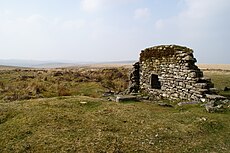Eylesbarrow tin mine

The side wall of stamping mill No. 2
|
|
| Location | |
|---|---|
| Location | Dartmoor |
| County | Devon |
| Country | England |
| Coordinates | 50°29′N 3°58′W / 50.48°N 3.97°WCoordinates: 50°29′N 3°58′W / 50.48°N 3.97°W |
| Production | |
| Products | Black tin, kaolin (minor) |
| History | |
| Opened | 1804 |
| Closed | 1852 |
| Owner | |
| Company | Various, see text |
Eylesbarrow mine was a tin mine on Dartmoor, Devon, England that was active during the first half of the 19th century. In its early years it was one of the largest and most prosperous of the Dartmoor tin mines, along with Whiteworks and the Birch Tor and Vitifer mines. Its name has several variant spellings, such as Eylesburrow, Ailsborough, Ellisborough, Hillsborough etc. It was also known as Wheal Ruth for a short period around 1850. The extensive remains lie to the north of the River Plym, less than 1 mile (1.6 km) north-east of Drizzlecombe, on the southern shoulder of the hill called Eylesbarrow on top of which are two prominent Bronze Age barrows.
The country rock of the mine is granite. The large mining sett (about 3 by 2 miles (4.8 by 3.2 km)) is crossed by many tin-bearing lodes which are substantially vertical and trend east-north-east. Most of the mine's excavations were made into just three of these lodes and were relatively shallow. The formation of the lodes was accompanied by extensive metasomatism which converted much of the plagioclase feldspar in the surrounding granite into the soft mineral kaolinite, and made excavation easier than it would have been in unaltered rock.
The lodes varied in width up to a maximum of around 2.4 ft (0.73 m) and were, at least in the early years of the mine's operation, sometimes of very high quality ore, uncontaminated with other unwanted ores. The existence of these high quality ores near the surface led the miners to believe that even better ore existed deeper down, but the history of the mine suggests that this is not the case and the mineralisation becomes patchy at depth.
Streaming and open-cast mining for tin have taken place in this part of Dartmoor for many centuries. It is believed that the industry on the moor was at its peak as early as the 12th century. For instance, in 1168, men from the nearby village of Sheepstor are known to have been "tinners". Around 550 years later a document of 1715 stated of Sheepstor Parish that "all the parishioners are tinners", but by this time working for tin on the moor was already in decline, probably because of the exhaustion of the easily accessible deposits.
...
Wikipedia

